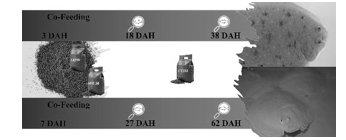OPTIMISING LARVAL NUTRITION IN FLATFISH USING PROTEIN HYDROLYSATES: GROWTH AND REDOX EFFECTS
Introduction
The farming of Senegalese sole (Solea senegalensis) and turbot (Scophthalmus maximus) is expanding driven by market demand and supported by advances in hatchery technology, including novel microdiets. However, optimising early-stage nutrition remains a major challenge. Live feeds, commonly used at first feeding, are nutritionally suboptimal—particularly regarding protein quality—and have been associated with inconsistent larval growth. Formulated microdiets, used to supplement live feeds in co-feeding regimes or to support earlier weaning, have been proposed as a solution, provided they are adapted to the limited digestive capacity of these altricial larvae. At mouth opening, fish larvae immature digestive tract lacks a functional stomach and gastric glands, limiting their ability to digest complex proteins such as fishmeal. Protein hydrolysates (PH), rich in free amino acids and small peptides, offer a more digestible protein source and have been shown to improve growth and survival in various marine fish species. The inclusion of PH from first feeding may support larvae through metamorphosis and improve long-term robustness, however their peptide profile needs to be optimized, to facilitate digestion, while preventing excessive leaching of amino acids into the water, and also an overload of the absorption and metabolic processes.
Material and Methods
Two trials were conducted at CCMAR facilities under optimal abiotic conditions using recirculating aquaculture systems. Two dietary treatments were tested in triplicate: LOW (a commercial-like diet rich in a low molecular weight PH) and HIGH (a similar diet rich in high molecular weight PH). Larvae were co-fed from mouth opening - 3 days after hatching (DAH) for Senegalese sole and 7 DAH for turbot - following CCMAR’s Aquaculture Research Group protocol. At the end of the pelagic phase (18 DAH for sole and 27 DAH for turbot), larvae were sampled to assess growth, survival, and redox status. Fish were then transferred to benthic rearing systems and fed a commercial-like diet until final sampling at 38 DAH (sole) and 62 DAH (turbot).
Results
During the pelagic phase, Senegalese sole larvae fed the HIGH diet showed significantly greater growth, suggesting a positive correlation between hydrolysate molecular weight and performance. In contrast, turbot larvae grew better on the LOW diet, indicating an inverse relationship. Redox status was unaffected at the end of the pelagic phase in both species. After metamorphosis, growth remained similar across treatments. However, in turbot, fish previously fed the LOW diet displayed higher total glutathione (GH) and catalase (CAT) activity, along with reduced lipid peroxidation (LPO), suggesting enhanced antioxidant capacity and improved cellular protection.
Conclusions
The inclusion of protein hydrolysates from mouth opening influenced early growth in a species-specific manner, with opposing effects observed in Senegalese sole and turbot. While redox status was unaffected during the pelagic phase, differences in antioxidant markers post-metamorphosis in turbot suggest that early dietary interventions may shape long-term physiological robustness. These findings highlight the potential of tailored hydrolysate-based diets to optimise early nutrition and resilience in flatfish aquaculture.
Acknowledgments
This work is part of project E!4876 FlatFIRST_1171, supported by EUROSTARS-3 program, and by Portugal and the European Union through ERDF, Algarve 2030, and COMPETE 2030, in the framework of Portugal 2030 and Portuguese national funds from FCT - Foundation for Science and Technology through project UIDB/04326/2020 (DOI:10.54499/UIDB/04326/2020), UIDP/04326/2020 (DOI:10.54499/UIDP/04326/2020) and LA/P/0101/2020 (DOI:10.54499/LA/P/0101/2020), and from the operational programmes CRESC Algarve 2020 and COMPETE 2020 through project EMBRC.PT ALG-01-0145-FEDER-022121 to CCMAR.
